Gold IRA
Gold: A Good Retirement Investment?
Tapping into the potential benefits of gold in retirement portfolios can offer stability and hedging opportunities, making it a compelling option for long-term financial security.

Gold can be a beneficial addition to retirement portfolios, offering stability and acting as a hedge against market fluctuations and economic uncertainties. Its historical performance has shown resilience and value retention over time, with a positive correlation to inflation. While gold investments can be volatile due to market influences and lack of consistent growth compared to other assets, integrating gold into a diversified portfolio brings potential benefits. Tax advantages in retirement accounts like IRAs make it attractive for investors seeking diversification and long-term stability. Understanding the risks and exploring incorporation methods can help individuals make informed decisions for their retirement planning.
Key Takeaways
- Gold offers stability during economic uncertainties in retirement.
- It acts as a hedge against inflation and market volatility.
- Including gold in a retirement portfolio aids in diversification.
- Gold investments in IRAs can provide tax advantages.
- Consult a financial advisor for managing gold investment risks.
Historical Performance of Gold
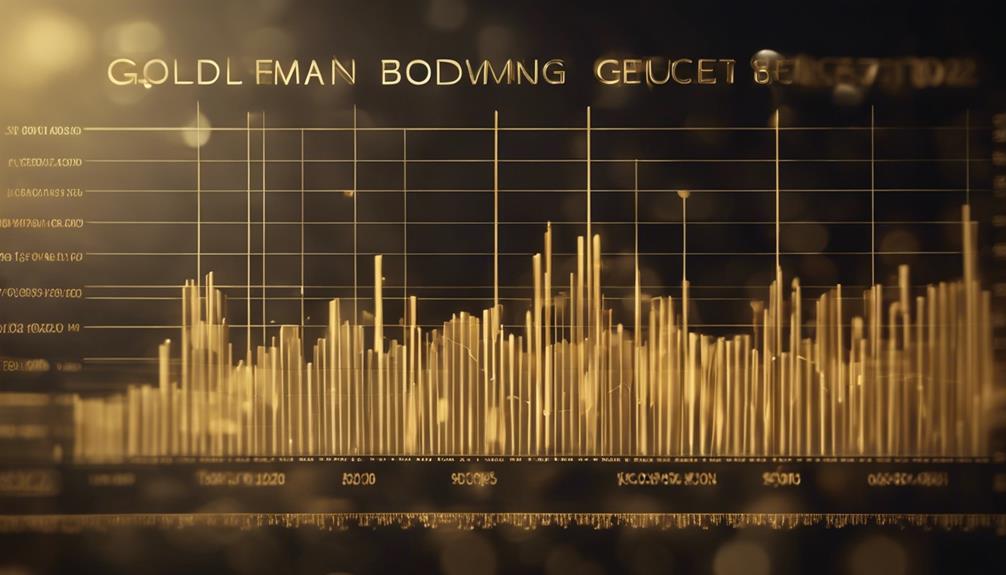
Gold has demonstrated impressive performance over various periods, surpassing the S&P 500 in multiple decades, particularly in the 1970s and early 2000s. Its historical performance as an investment has been remarkable, with the ability to maintain value over time and showcase resilience even in times of market volatility. The price of gold has shown a positive correlation with inflation, making it a potential hedge against rising prices for investors looking to secure their retirement funds.
Throughout history, gold has served as a safe-haven asset, especially during times of economic uncertainty. Investors seeking stability often turn to gold due to its reputation for preserving wealth when other assets may falter. The market behavior of gold during the 2008 financial crisis, where prices surged by over 25%, further highlights its role as a reliable investment option. Considering its track record and the characteristics that make it valuable, gold remains a compelling choice for those planning for retirement.
Benefits of Including Gold in Retirement

Emerging as a dependable asset during economic uncertainties, the inclusion of gold in retirement portfolios offers long-term returns and stability. By investing in gold, individuals can benefit from its ability to lower overall portfolio volatility, making it a valuable tool for diversification.
Gold's performance behavior, distinct from stocks and bonds, provides a hedge against inflation and economic instability, safeguarding retirement savings. Additionally, allocating gold in retirement accounts such as IRAs can potentially offer tax advantages, enhancing the financial benefits of this precious metal.
Investing in gold, whether through physical gold bullion or gold-related financial instruments, contributes to effective portfolio management. Keeping an eye on gold prices and integrating this precious metal into a diversified portfolio helps individuals secure their financial future and navigate market fluctuations with confidence.
The strategic inclusion of gold in retirement planning reflects a prudent approach towards ensuring a stable and robust financial foundation for the long term.
Risks Associated With Gold Investments

Experiencing price volatility and rapid market fluctuations, gold investments pose inherent risks that require careful consideration in retirement planning. The unpredictability of gold prices, heavily influenced by investor sentiment and market speculation, can make it a risky investment choice.
Unlike traditional investments, the value growth of gold hasn't consistently outpaced other major investment assets, highlighting its risk factors. Additionally, gold's limited industrial use compared to other commodities can contribute to its risky nature as an investment option.
Investors looking to diversify their portfolios by including gold should be aware of the challenges associated with its price stability in a dynamic market environment. Seeking advice from a financial advisor is essential in understanding and managing the risks tied to gold investments.
While gold can be a good investment for some, careful financial planning and informed decision-making are essential when considering the incorporation of gold into retirement portfolios, including through Best Gold IRAs that allow individuals to hold precious metals.
How to Incorporate Gold in Your Portfolio

Considering the significance of diversification in investment portfolios, incorporating gold can offer stability and serve as a hedge against market fluctuations in retirement planning. To effectively add gold to your portfolio, individuals should evaluate the tax advantages offered by different types of IRAs, such as traditional, Roth, or SEP IRAs, for gold investments. It is essential to select an IRS-approved custodian to hold physical gold bars or coins within a gold IRA securely. Consulting with a reputable gold investment company can provide valuable insights into the process and various options available for integrating gold into your retirement portfolio. The table below outlines key steps to help individuals understand how to incorporate gold into their investment strategy:
| Step | Description |
|---|---|
| Evaluate IRA Options | Assess tax advantages of traditional, Roth, or SEP IRAs for gold investments. |
| Choose an IRS-Approved Custodian | Select a secure custodian to hold physical gold bars or coins in a gold IRA. |
| Consult with Gold Investment Co. | Seek guidance from a reputable gold investment company to explore incorporation options. |
Comparing Gold to Other Retirement Assets

When comparing gold to other retirement assets, investors often consider its unique role as a diversification tool rather than a primary growth asset. Gold historically has lower returns compared to stocks and bonds in retirement portfolios. Its value growth hasn't outpaced major investment assets like equities over time.
Gold prices can fluctuate rapidly, making it a more volatile investment compared to traditional retirement assets. The stability of gold as a store of value is due to its rarity and lack of practical utility, making it a unique addition to retirement holdings. Incorporating gold into an IRA allows investors to hold gold as part of their overall portfolio.
During a financial crisis, gold's value may provide a hedge against market volatility. There's a wide range of types of gold that can be considered as an investment asset, each with its own market price fluctuations. When deciding between an IRA and holding physical gold, investors should weigh the benefits of diversification and potential growth against the historical performance and stability of traditional retirement assets.
Frequently Asked Questions
Is It Good to Invest in Gold When You Retire?
Investing in gold during retirement can be beneficial for diversification and hedging against market volatility. It offers stability and historical value retention, making it a popular choice.
Gold's performance is tied to economic conditions, making it a strategic asset for retirement planning. Including gold in a retirement portfolio can help guard against inflation and market downturns.
It should be part of a well-rounded investment strategy for retirement security.
Is Gold Better Than 401k?
Gold can offer diversification benefits and act as a hedge against market volatility and economic uncertainty, potentially reducing overall portfolio risk.
While 401(k) plans primarily consist of stocks, bonds, and mutual funds, adding gold to a retirement portfolio can enhance diversification and provide a counterbalance to market fluctuations.
It's imperative to take into account individual financial goals and risk tolerance when determining whether gold or a 401(k) is a better investment option.
How Much Gold Do I Need to Retire?
When determining how much gold to include in a retirement plan, individuals should consider their financial goals and risk tolerance. Experts suggest allocating 5% to 10% of the portfolio to gold for diversification. Consulting with a financial advisor can help determine the best amount.
Evaluating gold's role within the overall investment strategy is essential for achieving long-term retirement objectives effectively. Gold can provide a hedge against economic uncertainties and inflation, enhancing portfolio resilience.
Is It Still a Good Idea to Invest in Gold?
When considering investing in gold, it's important to evaluate current market conditions and individual financial goals. Gold can serve as a valuable asset in a diversified retirement portfolio due to its historical performance during economic uncertainties.
While its value can be influenced by various factors, it offers stability and long-term value retention. Investors should assess their risk tolerance and consult with financial advisors to determine if gold aligns with their retirement investment strategy.
Conclusion
To sum up, while some may view gold as a traditional safe haven for retirement investments, its fluctuating performance and lack of income generation may not always be the best choice.
Investors should carefully consider the risks and benefits of including gold in their portfolios, weighing it against other assets like stocks and bonds.
Ultimately, the decision to invest in gold for retirement should be based on individual financial goals and risk tolerance, rather than simply following conventional wisdom.
Nancy oversees all content creation at The Liberty Portfolio. Her exceptional skill in translating complex financial concepts into clear, actionable advice makes her an invaluable asset to the team. Under her guidance, our content is informative and engaging, ensuring that readers from all backgrounds can understand and apply our advice. Nancy’s leadership in the content team ensures that our educational materials meet high standards of clarity and accuracy.
Gold IRA
Should I Roll My 401K Into a Gold Ira?
Hesitant about rolling your 401k into a Gold IRA? Discover strategic benefits and potential pitfalls to make an informed decision.

Rolling your 401k into a Gold IRA can be strategic. Gold IRAs diversify your retirement portfolio, hedging against inflation and offering tax benefits. However, consider challenges like gold's liquidity issues and price volatility. Rollover steps include notifying your plan administrator, understanding rollover methods, and tax implications. Gold IRAs offer potential tax deductions and relief from inheritance taxes. Choose a reputable company with secure storage, IRS-approved metals, and a strong track record. Diversifying with gold can protect against market volatility and provide asset resilience. Explore further benefits by exploring gold's role in uncertain market times.
Key Takeaways
- Consider diversifying with gold to hedge against market volatility and inflation.
- Evaluate tax benefits like tax-deferred growth and relief from inheritance taxes.
- Assess the potential impact of fluctuating gold prices on the value of your investment.
- Understand the 60-day window for rollover and potential tax consequences.
- Consult with a tax professional and choose a reputable Gold IRA company aligned with your investment goals.
Pros and Cons of Gold IRAs

When contemplating rolling over a 401K into a Gold IRA, it's important to weigh the pros and cons of this investment option. Gold IRAs offer a unique opportunity to diversify a retirement portfolio by including precious metals like gold. This diversification can provide a hedge against inflation and economic uncertainties, as gold often performs differently than traditional financial assets such as stocks and bonds. Additionally, the tax benefits of a Gold IRA are notable, with tax-deferred growth and potential relief from inheritance taxes being attractive features.
However, there are considerations to keep in mind. One such consideration is the potential liquidity of gold investments, as they may not be as easily converted to cash compared to traditional assets. Moreover, fluctuating gold prices can impact the value of a Gold IRA, leading to both risks and opportunities. Understanding these pros and cons is important when evaluating whether a Gold IRA aligns with one's financial goals and risk tolerance.
Steps to Rollover Your 401k

Initiating the rollover process involves notifying the 401(k) plan administrator about transferring funds to a Gold IRA. When moving your retirement savings, you can opt for either a direct or indirect rollover method.
With direct rollovers, funds seamlessly transfer from a 401(k) to a Gold IRA without incurring tax penalties. On the other hand, indirect rollovers necessitate withdrawing funds and depositing them into a Gold IRA within a 60-day window to avoid tax implications.
It's important to ensure compliance with rollover requirements to smoothly shift your funds. By understanding the transfer funds process and the 60-day window, you can successfully rollover your 401(k) into a Gold IRA while considering any potential tax consequences.
Make informed decisions to safeguard your retirement savings and adhere to the necessary steps for a secure rollover process.
Tax Implications of Gold IRAs
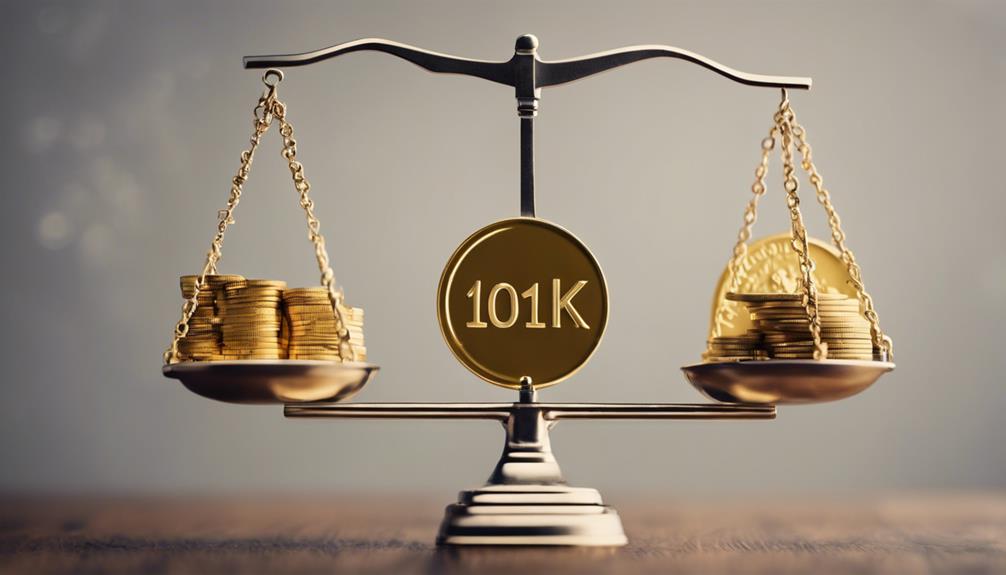
Contributions to Gold IRAs may offer tax-deductible benefits depending on income levels and retirement plan coverage. Earnings within a Gold IRA grow tax-deferred, meaning taxes on gains are postponed until withdrawal. Early withdrawals before age 59 ½ can lead to a 10% penalty on top of regular taxes. To navigate the tax complexities and potential liquidity issues, consulting a tax professional is recommended. Gold IRAs can also provide relief from inheritance taxes, allow for pre-tax deductions, and offer tax deferment until distributions. Understanding the tax implications is vital for making informed decisions about retirement savings. Below is a table summarizing key tax-related aspects of Gold IRAs:
| Tax Implications | Description |
|---|---|
| Tax-deductible Contributions | Benefits based on income levels and retirement plan coverage. |
| Tax-deferred Earnings | Gains grow tax-free until withdrawal. |
| Early Withdrawal Penalty | 10% penalty for withdrawals before age 59 ½ in addition to regular taxes. |
Choosing a Gold IRA Company

To select a reputable Gold IRA company, assess factors such as their reputation, fees, and range of services offered. When considering Gold IRA companies, look for names like Augusta Precious Metals and Goldco known for their quality products and excellent customer service.
Confirm that the company offers IRS-approved precious metals for investment within the Gold IRA. Verify the availability of secure storage options provided by the Gold IRA company to safeguard your investments.
Additionally, research custodians with a strong track record in handling Gold IRAs to entrust your financial future with a reliable partner. By focusing on these key aspects, you can make an informed decision when choosing a Gold IRA company that aligns with your investment goals and priorities.
Benefits of Diversifying With Gold

Diversifying with gold in a Gold IRA offers a reliable hedge against stock market volatility and economic uncertainties. Including gold in your retirement portfolio can provide various benefits such as asset protection, a store of value, and a hedge against inflation. Gold has historically shown resilience during times of market turbulence, making it an appealing option for those seeking stability.
| Benefits of Diversifying With Gold |
|---|
| – Hedge against market volatility |
| – Asset protection |
| – Store of value |
Frequently Asked Questions
Should You Convert 401K to Gold?
We believe converting a 401(k) to gold can diversify a retirement portfolio. Gold IRAs protect against inflation and market uncertainties, hedging against stock volatility.
This move allows owning physical gold or precious metals for long-term stability and growth potential. Consider these benefits when deciding whether to convert a 401(k) to gold.
Can I Roll My 401K Into a Gold Ira?
Yes, we can roll our 401(k) into a Gold IRA to diversify our retirement portfolio. This transfer lets us invest in physical gold and other precious metals, offering protection against economic downturns and inflation. Owning tangible assets in a tax-advantaged account can be beneficial.
Before rolling over our 401(k) into a Gold IRA, let's carefully consider the tax implications and potential benefits for a secure financial future.
What Are the Cons of a Gold Ira?
The drawbacks of a Gold IRA include:
- Higher fees
- Volatile gold values impacting account balances
- The need for secure storage
- Complex and time-consuming selling processes
- Lower liquidity compared to stocks and bonds
These factors can affect the overall performance and accessibility of a Gold IRA, making it important for investors to carefully consider these drawbacks before making investment decisions.
Should I Convert My IRA to Gold?
When considering converting an IRA to gold, it's crucial to evaluate the potential benefits and risks carefully. Diversifying retirement savings with physical precious metals like gold, silver, platinum, and palladium can offer a hedge against economic uncertainty.
However, verify compliance with IRS standards for metal quality. Analyze your investment goals and risk tolerance before making this decision.
Conduct thorough research and consult with financial experts to make an informed choice.
Conclusion
To sum up, contemplating rolling your 401k into a Gold IRA can provide diversification and protection against economic uncertainties.
One interesting statistic to take into account is that gold has historically maintained its value over time, serving as a hedge against inflation and market volatility.
This makes it a valuable asset to ponder adding to your retirement portfolio.
Make sure to carefully weigh the pros and cons, understand the tax implications, and choose a reputable Gold IRA company before making any decisions.
William is the voice of The Liberty Portfolio within our community. He manages all interactions with our readers through social media and website forums, ensuring that every query is answered and feedback is incorporated into our ongoing improvements. William’s role is crucial in building and maintaining strong relationships with our audience, fostering an engaging and supportive online environment for everyone interested in better managing their retirement planning.
Gold IRA
10 Precious Metals IRA Options
Intrigued by the idea of diversifying your retirement portfolio with precious metals?
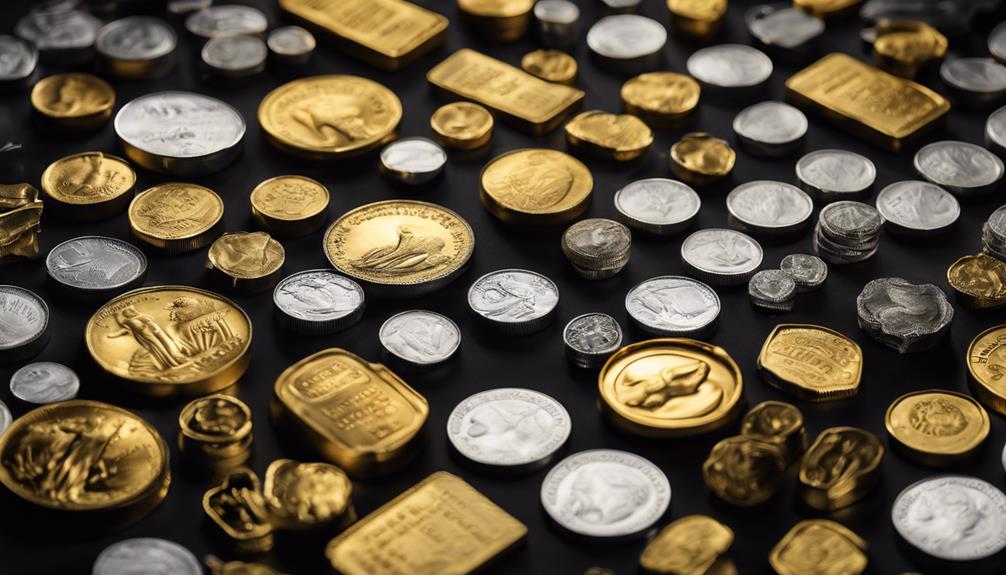
Explore 10 precious metals IRA options, such as Gold, Silver, Platinum, and Palladium IRAs. Gold IRAs allow diversification with physical gold bullion or coins. Silver IRAs feature coins like American Eagle and Canadian Maple Leaf. Platinum IRAs include products meeting IRS purity standards. Palladium IRAs offer diversification and tax advantages. Physical Gold IRAs store gold securely for tax benefits. Diversify with Silver Coins like American Eagle for market stability. Tax advantages in Precious Metals IRAs include potential tax-deductible contributions. Consider a reputable IRA custodian for compliance. Discover unique benefits and opportunities in precious metals IRAs. Further insights into diversifying and securing your retirement await.
Key Takeaways
- Gold IRA for diversification and tax benefits.
- Silver IRA with 99.9% purity coins.
- Platinum IRA for industrial uses and diversification.
- Consider Palladium IRA for investment diversification.
- Tax advantages and storage considerations are crucial.
Gold IRA Basics

In understanding the fundamentals of Gold IRA, investors can establish a specialized individual retirement account to hold gold as a qualified investment for their retirement planning. A Gold IRA allows individuals to diversify their retirement portfolio by including physical metals like gold bullion or coins.
Unlike traditional retirement accounts, Gold IRAs must be held separately for tax purposes. Investors looking to open a Gold IRA can do so through specialty custodians or broker-dealers, ensuring compliance with IRS regulations. The IRS permits self-directed IRA holders to purchase approved physical forms of precious metals, including gold, silver, platinum, and palladium, for their Gold IRA accounts.
Silver IRA Investment Options

When considering Silver IRA investment options, individuals can explore a variety of coins like American Eagle, Australian Kookaburra, Canadian Maple Leaf, and Mexican Libertad. These coins must have a purity of 99.9% and be stored in an IRS-approved depository to qualify for a Silver IRA.
Silver IRA Benefits
Investors exploring retirement planning may find significant advantages in incorporating Silver IRA options to diversify their portfolios and hedge against economic volatility. Silver IRAs offer a tax-advantaged retirement account where investors can hold silver bullion coins like American Silver Eagles. Silver's value can act as a hedge against inflation and uncertainty, making it a popular choice for diversifying a portfolio and protecting wealth.
With its industrial applications, silver provides long-term growth potential. Contributions to Silver IRAs are subject to IRS limits, with those aged 50 and over eligible for additional catch-up contributions. By investing in Silver IRAs, individuals can benefit from both the intrinsic value of silver as a precious metal and its practical uses in various industries.
Silver IRA Providers
Several reputable providers offer a range of silver IRA investment options, allowing investors to diversify their retirement portfolios with IRS-approved silver coins and bars. Popular choices include the American Silver Eagle and Canadian Silver Maple Leaf coins.
Silver IRAs provide a tangible asset that can act as a hedge against economic uncertainty, making them attractive options for those looking to safeguard their retirement savings. When selecting a silver IRA provider, it is crucial to work with reputable companies to guarantee compliance with IRS regulations and proper storage of the precious metals.
Platinum IRA Considerations
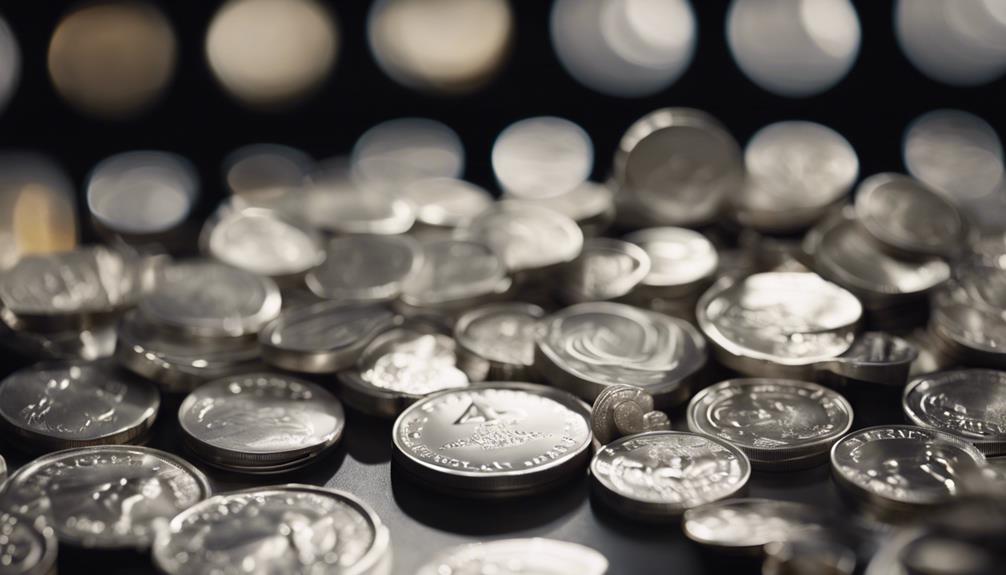
Given the growing interest in diversifying retirement portfolios with precious metals, considering platinum IRAs as a strategic investment option can provide valuable benefits for investors. When looking into Platinum IRA considerations, here are some key points to keep in mind:
- IRA Purity Standards: Platinum IRAs allow investors to hold platinum coins and bullion bars that meet IRS purity standards.
- Accepted Platinum Products: Investors can include a variety of platinum products in their IRA, such as American Eagle coins, Australian Koala coins, Canadian Maple Leaf coins, and Isle of Man Noble coins.
- Diversification: Including platinum in a retirement portfolio can help diversify it with a rare and valuable precious metal that has both industrial and investment uses.
- Tax Advantages: Platinum IRAs offer tax advantages similar to other precious metals IRAs, making them a potentially beneficial option for retirement savings.
Palladium IRA Opportunities
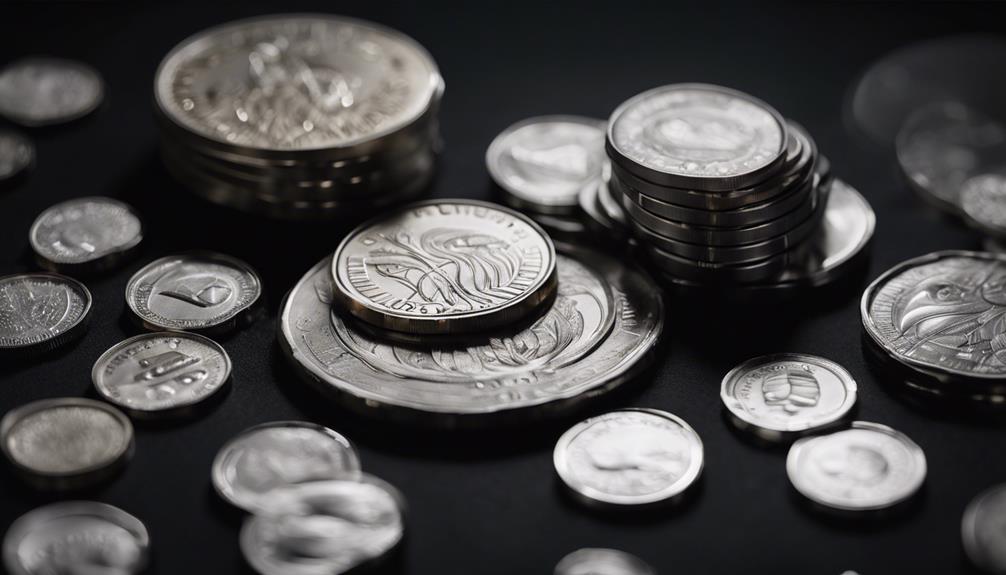
When considering Palladium IRA opportunities, investors can explore the basics of including palladium in their retirement portfolios and the potential benefits it offers.
Palladium IRAs present a way to diversify investment holdings, especially for those interested in precious metals.
Understanding the fundamentals and advantages of Palladium IRAs can help individuals make informed decisions about their retirement savings strategies.
Palladium IRA Basics
Among the various options for holding precious metals in a tax-advantaged retirement account, Palladium IRAs provide investors with the opportunity to include palladium meeting purity standards of 99.95%. When considering Palladium IRA basics, investors should keep in mind:
- Tax Advantaged: Palladium IRAs offer tax benefits similar to other types of IRAs.
- Diversification: Including palladium in an IRA allows investors to diversify their precious metals holdings.
- Purity Standards: Palladium held in a Palladium IRA must meet purity standards of 99.95%.
- Withdrawals: Contributions and withdrawals from a Palladium IRA are subject to IRS rules and regulations.
Understanding these basics can help investors make informed decisions when considering palladium as part of their retirement portfolio.
Benefits of Palladium IRA
What advantages does investing in a Palladium IRA offer for individuals seeking to diversify their retirement portfolios with precious metals?
Palladium, unlike gold and silver, has showcased strong growth potential in recent years, making it a compelling investment option. Its significant role in catalytic converters for vehicles guarantees a stable demand and price resilience. By incorporating Palladium into a precious metals IRA, investors can benefit from diversification due to its unique industrial and investment demand.
With limited global supply compared to gold, Palladium presents attractive long-term investment potential. Influenced by factors like automobile production and economic growth, Palladium prices offer opportunities for investors to capitalize on market fluctuations.
Physical Gold IRA Benefits

Investors who opt for a Physical Gold IRA can benefit from storing their gold in a secure IRS-approved facility while enjoying tax advantages and portfolio diversification. Here are some key advantages of a Physical Gold IRA:
- Tax Advantages: Gold IRAs offer tax benefits such as tax-deferred growth and potentially tax-free withdrawals during retirement, providing investors with a tax-efficient way to save for the future.
- Portfolio Diversification: By including physical gold in a retirement account, investors can diversify their portfolios beyond traditional assets like stocks and bonds, reducing overall risk through broader asset allocation.
- Hedge Against Economic Uncertainty: Holding physical gold in a Gold IRA can act as a safeguard against economic instability, offering a store of value that tends to perform well during times of market volatility or inflation.
- Self-Directed Retirement Account: Gold IRAs are self-directed accounts that empower individuals to make investment decisions, including choosing to invest in precious metals like physical gold, giving more control over their retirement savings strategy.
ETFs for Precious Metals IRAs

Exchange-Traded Funds (ETFs) present a convenient investment avenue for Precious Metals IRAs, offering indirect exposure to precious metals like gold, silver, platinum, and palladium. Investors can acquire shares of ETFs that mirror the performance of these metals, providing a way to benefit from their values without needing to own physical metal directly.
These ETFs, traded on major stock exchanges, offer liquidity, making them easily tradable within Precious Metals IRAs. Typically, ETFs based on precious metals hold physical metal or futures contracts, ensuring diversified exposure to the metals market.
For IRA investors seeking to include precious metals in their portfolios without the hassle of owning physical metals, precious metal ETFs can be a suitable option. By investing in these ETFs, individuals can access the potential benefits of precious metals within a well-regulated investment framework, making it a convenient choice for those looking to diversify their retirement savings.
Diversifying With Silver Coins
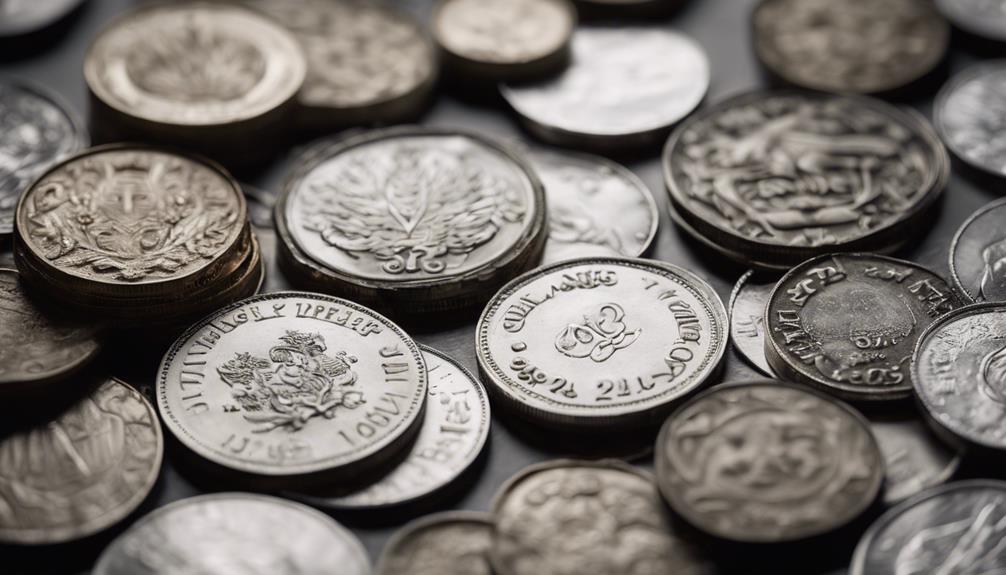
When contemplating diversification within a Precious Metals IRA, silver coins like the American Eagle, Canadian Maple Leaf, and Mexican Libertad offer tangible benefits. These coins meet the required purity standards for IRA investment and can provide a hedge against market fluctuations.
Investors also need to take into account storage considerations when including silver coins in their IRA portfolio.
Benefits of Silver
Diversifying a precious metals IRA with silver coins can enhance portfolio resilience and market flexibility. When considering the benefits of silver in a precious metals portfolio, it's important to note:
- Affordability: Silver coins are often more accessible than other precious metals, allowing for easier entry into the market.
- Market Tradability: Silver coins provide investors with a tangible asset that is easily tradable, offering liquidity when needed.
- Industrial Applications: Silver's industrial demand adds another layer of value, diversifying the portfolio across sectors.
- Balance Risk: Adding silver coins can help balance the overall risk in a precious metals portfolio, providing stability in times of market volatility.
Investment Potential
Silver coins, as a tangible investment option within a Precious Metals IRA, offer investors a strategic opportunity to diversify their portfolio beyond gold. Investing in silver coins provides a hedge against inflation and market volatility, similar to gold.
These coins, such as American Silver Eagles or Canadian Silver Maple Leafs, meet IRA purity requirements, ensuring their eligibility for inclusion in the IRA. Due to their global recognition, silver coins are considered a liquid asset within the Precious Metals IRA, allowing for potential future sales.
Storage Considerations
Proper storage practices play a critical role in safeguarding the value and integrity of silver coins held within a Precious Metals IRA.
- IRS-Approved Depository: Storing silver coins in an IRS-approved facility ensures compliance with IRA regulations.
- Minimum Purity Standards: Silver coins must meet minimum purity standards to be eligible for inclusion in a precious metals IRA.
- Diversification Benefits: Diversifying with silver coins can help protect against market volatility and inflation.
- Value Maintenance: Proper storage of silver coins is essential to maintain their value and integrity within a precious metals IRA.
Tax Advantages of Precious Metals IRAs

Investors seeking to build a tax-efficient retirement portfolio may find significant benefits in utilizing a Precious Metals IRA due to the tax advantages it offers, including tax-deferred growth on investments held within the account. Contributions made to a precious metals IRA can potentially be tax-deductible, providing an opportunity to reduce taxable income.
In addition, withdrawals from a precious metals IRA upon reaching retirement age may be subject to taxation at the individual's current income tax rate. Transferring funds from a traditional IRA to a precious metals IRA can be accomplished without immediate tax consequences, offering a seamless way to reallocate investments.
Choosing a Reputable IRA Custodian
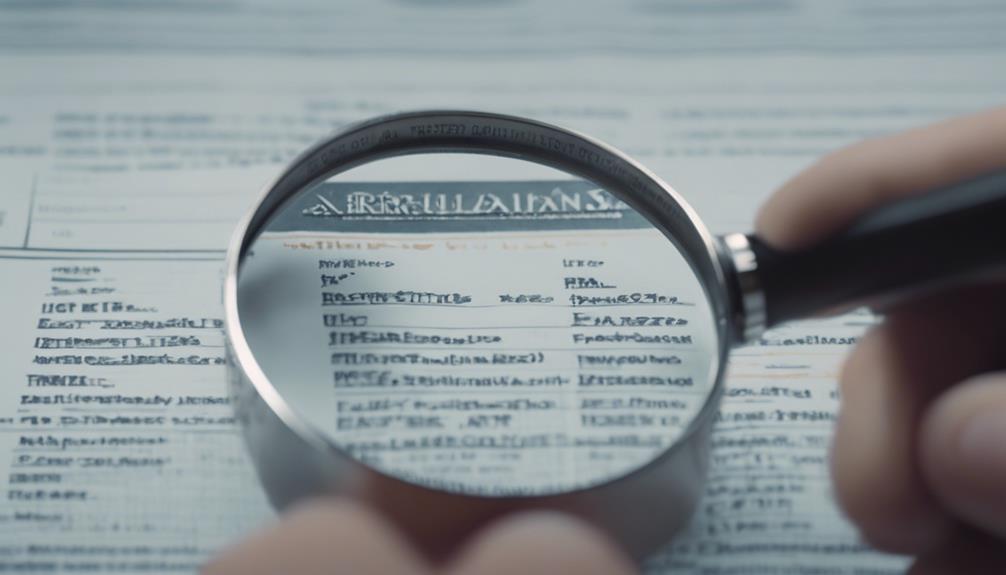
Selecting a trustworthy and experienced IRA custodian is an important step in establishing a secure and compliant Precious Metals IRA. When choosing a reputable IRA custodian, consider the following:
- IRS Approval: Make sure the IRA custodian is an IRS-approved trustee for holding precious metals in your IRA to guarantee compliance with regulations.
- Experience: Look for custodians with a track record in handling precious metals IRAs as this expertise ensures adherence to IRS guidelines.
- Segregated Storage: Verify that the custodian offers segregated storage for your precious metals, maintaining individual ownership and protecting your assets.
- Fee Structure: Consider the custodian's fee structure, including setup, administrative, and storage fees. Understanding these costs upfront is important for making an informed decision and avoiding surprises.
When researching custodians, explore reviews, ratings, and reputation to select a trustworthy and reliable partner for your precious metals IRA. A well-established and reputable IRA custodian can provide the security and peace of mind necessary for managing your precious metals investments effectively.
Balancing Risk in Your IRA

Balancing risk within your IRA through strategic asset diversification is essential for safeguarding against market volatility and enhancing long-term portfolio stability. Diversifying your portfolio with precious metals such as gold, silver, platinum, or palladium can act as a hedge against economic uncertainty and inflation, providing stability during turbulent market conditions. By allocating a portion of your IRA to precious metals, you spread risk and potentially enhance overall portfolio performance. Gold and other precious metals have historically shown low correlation with traditional assets, making them valuable for risk management in an IRA. Properly balancing risk in your IRA with precious metals not only mitigates market volatility but also contributes to long-term wealth preservation and growth opportunities.
| Advantages of Precious Metals in an IRA | |
|---|---|
| Acts as a hedge against economic uncertainty | Provides stability in turbulent markets |
| Low correlation with traditional assets | Enhances risk management in an IRA |
Frequently Asked Questions
What Is the Best Precious Metals Ira?
When determining the best precious metals IRA, individual investment objectives, risk tolerance, and desired exposure to metals play important roles. Factors such as fees, storage options, and the reputation of the IRA custodian are key considerations.
Extensive research and comparisons of different providers are essential in finding a suitable match. Seek experienced custodians with a compliance record with IRS regulations. Evaluate the range of metals offered, quality of customer service, and ease of account management for best decision-making.
Can You Buy Precious Metals in an Ira?
Yes, individuals can purchase precious metals in an IRA. This option offers a unique opportunity for diversification within retirement savings.
By investing in approved physical forms of gold, silver, platinum, or palladium, IRA holders can potentially hedge against economic uncertainty and inflation.
It's essential to note that these precious metals must meet specific purity standards and be stored at an IRS-approved facility, ensuring compliance with regulations and safeguarding the investment.
What Are the Negatives of a Precious Metals Ira?
Some negatives of a precious metals IRA include:
- High fees such as setup, maintenance, and storage fees.
- Potential volatility in metal values affecting IRA value.
- Lack of dividends or interest.
- Possible taxes and penalties on early withdrawals.
- The need for a long-term investment horizon due to potential lack of immediate profits.
These factors should be carefully considered when evaluating the suitability of a precious metals IRA for investment purposes.
What Are the IRS Rules for Precious Metals Ira?
The IRS rules for Precious Metals IRA stipulate specific purity requirements for different metals:
- Gold must be 99.5% pure.
- Silver must be 99.9% pure.
- Platinum and palladium must be 99.95% pure.
Additionally, precious metals in a Gold IRA must originate from accredited refiners or mints to comply with IRS standards.
Proof coins within a Precious Metals IRA must be in their original mint packaging as per IRS regulations to meet the criteria for inclusion.
Conclusion
To sum up, investing in a precious metals IRA can provide a secure and diverse portfolio option for individuals looking to safeguard their wealth.
While exploring the world of precious metals can be challenging, the potential benefits of gold, silver, platinum, and palladium investments can outweigh the risks.
By carefully considering the options available and working with a reputable IRA custodian, investors can balance risk and potentially reap the rewards of a well-managed precious metals IRA.
Sophia is the analytical powerhouse of The Liberty Portfolio. Her keen analytical skills and meticulous attention to detail help us stay ahead of the curve. Sophia is responsible for researching current trends, data analysis, and regulatory changes that impact retirement planning. Her rigorous analysis underpins our content, providing the depth and accuracy that our users rely on for making critical investment decisions.
Gold IRA
Investment Strategies Involving Gold IRAs for Maximizing Retirement Wealth
Diversify your retirement portfolio with Gold IRAs to enhance growth potential and safeguard against market volatility – find out how!

Strategically allocating 5-10% of savings to gold within a Gold IRA enhances portfolio diversification. This safeguard against market volatility and inflation boosts overall growth potential for retirement wealth. Evaluating reputable Gold IRA companies is important for cost-effectiveness. Analyzing fees, storage options, and company reputation optimizes retirement investment outcomes. Adhering to IRS regulations on gold purity guarantees tax benefits across investments. Monitoring long-term growth prospects, tax advantages, and timing gold investments based on market trends are key for maximizing wealth. Understanding these strategies can lead to a secure financial future with optimized retirement savings.
Key Takeaways
- Allocate 5-10% savings to gold for diversification benefits.
- Utilize Gold IRA to safeguard against market volatility and inflation.
- Enhance portfolio growth potential by including gold investments.
- Determine optimal portfolio allocation for maximizing retirement wealth.
- Secure financial future with a balanced approach to investments.
Gold IRA Allocation Strategies

When considering Gold IRA allocation strategies, it is prudent to allocate 5-10% of your savings to gold for diversification purposes. Gold IRA allocation serves as a safeguard against inflation and market volatility, offering stability in times of economic uncertainty.
Including gold in diverse asset categories within your investment plan can enhance the overall growth potential of your portfolio. By strategically determining the best portfolio allocation for your Gold IRA, you can effectively maximize your retirement wealth over the long term.
These investment strategies involving gold IRAs provide a balanced approach to wealth management, ensuring a secure financial future. Through careful consideration and professional advice, individuals can navigate the complexities of the market and capitalize on the benefits of including gold in their retirement investment plans.
Embracing Gold IRA allocation strategies as part of a thorough investment plan is a wise decision that can lead to significant long-term financial growth and stability.
Evaluating Gold IRA Companies
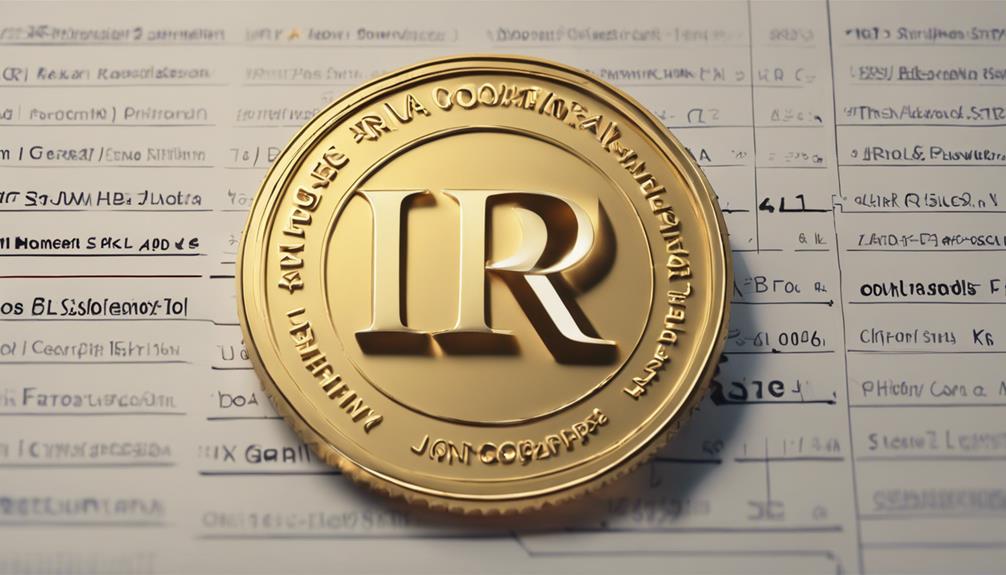
When evaluating gold IRA companies, it's important to consider several key factors:
- Analyze the company's reputation by looking into its track record and customer feedback. This can help gauge its reliability and trustworthiness.
- Compare fees and charges associated with investing in a gold IRA. Understanding the cost structure can ensure that you are not overpaying for services.
- Assess the storage options available. Different companies offer varying storage facilities, so it's important to choose one that meets your needs and preferences.
Company Reputation Analysis
When evaluating Gold IRA companies for their reputation, thorough scrutiny of customer feedback, industry standing, and financial transparency is essential.
- Customer Reviews: Assess customer satisfaction through reviews and ratings.
- Track Record: Research company history to evaluate reliability and performance.
- Industry Accreditations: Check affiliations to guarantee compliance with standards and regulations.
- Fees and Charges Comparison: Compare costs across companies for cost-effectiveness.
Fees and Charges Comparison
Conducting a thorough assessment of fees and charges is essential when evaluating Gold IRA companies for investment suitability. When comparing companies, consider the markup or spread percentages, typically ranging from 5% to 12% above market value.
Additionally, factor in shipping and handling costs for gold IRA investments, which vary based on quantity and delivery destination. Evaluate the commissions charged by companies as a percentage of the transaction amount to understand potential costs.
It's also important to look into liquidation fees, which can be a fixed amount or a percentage of the value of sold metals. Lastly, examine verification charges for purity and weight compliance with IRS standards when comparing fees among different gold IRA companies.
Storage Options Assessment
Evaluating the reliability and security of storage options provided by Gold IRA companies is a critical aspect of determining their suitability for safeguarding physical gold investments. When examining storage options, consider the following:
- Location and Reputation: Examine where the storage facilities are situated and the reputation of these locations.
- IRS-Approved Depositories: Confirm that the storage facilities used are IRS-approved depositories to comply with regulations.
- Storage Fees: Compare the storage fees charged by different Gold IRA companies to understand their impact on investment returns.
- Transparency and Insurance Coverage: Look for transparency in storage procedures and the insurance coverage provided by Gold IRA companies to protect your investments effectively.
IRS Regulations and Quality Standards

Adhering to IRS regulations and quality standards is essential when considering gold and silver investments within Individual Retirement Accounts (IRAs). The IRS mandates a minimum gold purity of 99.5% and a silver purity standard of 99.9% for precious metal investments held in IRAs. It is vital to confirm compliance with IRS guidelines to reap the associated tax benefits.
Selecting IRA custodians who strictly adhere to IRS regulations for gold IRAs is critical to avoid potential tax consequences. By following the IRS standards for gold investments, investors can navigate the complexities of tax requirements and safeguard their retirement savings.
Maintaining gold and silver purity within the specified limits not only aligns with IRS requirements for precious metals in IRAs but also contributes to a secure and compliant investment strategy that maximizes long-term growth potential. Consequently, staying informed about IRS regulations and quality standards is key to optimizing the benefits of gold IRAs while minimizing tax liabilities.
Long-Term Growth Potential Assessment

When contemplating the long-term growth potential of gold IRAs for retirement wealth, it is crucial to conduct a comprehensive analysis of growth prospects, evaluate future performance, and examine the investment horizon.
By appraising these key points, investors can make informed decisions that align with their retirement planning goals and objectives.
Understanding the dynamics of gold investments over time can help maximize wealth preservation and long-term financial security.
Growth Prospects Analysis
Evaluating the long-term growth potential of Gold IRAs requires a thorough examination of historical performance and market trends. When considering the growth prospects, it is essential to understand the following key points:
- Gold IRAs historically demonstrate stability and appreciation over time.
- Long-term growth potential aligns well with retirement investment timelines.
- Knowledge of gold investments plays an important role in maximizing growth within a gold IRA.
- Regular monitoring and adjustments are necessary to optimize the growth potential of a gold IRA.
Future Performance Evaluation
Evaluating the future performance of Gold IRAs involves a thorough examination of their long-term growth potential through historical data and market projections. Gold has a track record of appreciating in value over time, making it a suitable option for retirement investment portfolios.
Understanding the characteristics of gold investments is important for evaluating their long-term growth potential. By regularly monitoring and adjusting gold IRA investments, individuals can optimize opportunities for long-term growth.
Investing in gold IRAs can also act as a safeguard against market fluctuations and inflation, providing stability and security for retirement savings. Keeping a close eye on how gold investments perform over time and making necessary adjustments can help ensure that long-term growth potential is maximized.
Investment Horizon Examination
For an in-depth assessment of the long-term growth potential of Gold IRAs, a thorough examination of the investment horizon is essential. When considering the long-term growth potential of a gold IRA for retirement planning, it is imperative to analyze historical trends and patterns. Here are four key aspects to focus on:
- Stability: Gold's historical stability makes it a reliable asset for long-term growth in retirement savings.
- Appreciation: Over time, gold investments have shown consistent appreciation, making them attractive for retirement wealth accumulation.
- Monitoring: Regularly monitoring the performance of gold within an IRA is necessary to track its long-term growth potential.
- Adjustments: Making strategic adjustments to your gold IRA holdings can help optimize long-term growth and maximize retirement wealth.
Tax Advantages in Gold IRAs
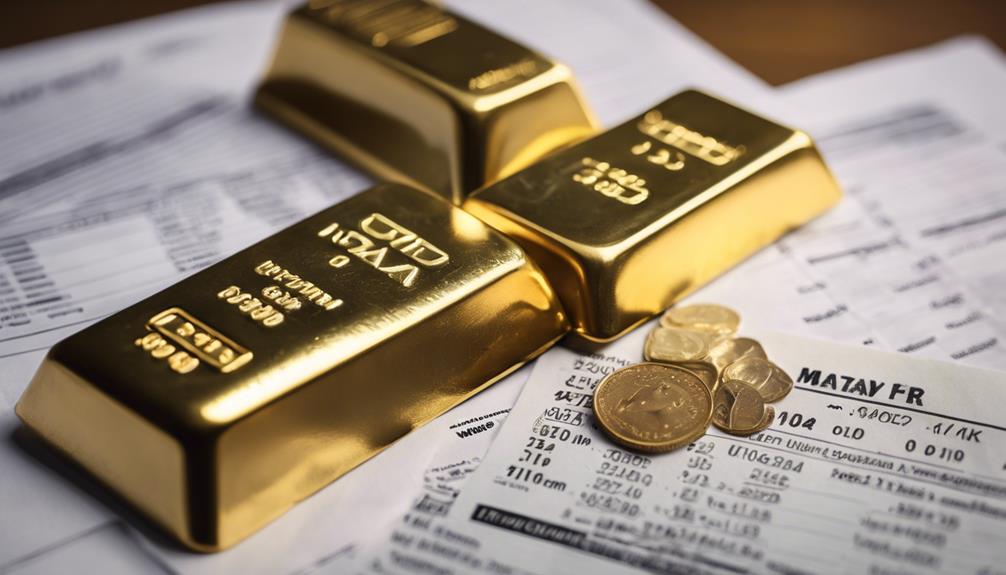
Enjoying tax-deferred growth on investments, Gold IRAs provide a strategic advantage for individuals seeking to maximize their retirement wealth through gold ownership. Contributions to a Gold IRA can be made with pre-tax dollars, offering a tax advantage similar to traditional retirement accounts.
When it comes time to make withdrawals from a Gold IRA, these are taxed as ordinary income, aligning with the tax treatment of traditional IRAs. This tax-efficient structure shields investors from immediate tax implications, unlike physical gold ownership outside of an IRA which may trigger capital gains taxes upon sale.
The tax benefits of a Gold IRA make it an attractive vehicle for long-term retirement planning, allowing potential earnings to grow without being eroded by taxes along the way. By understanding the tax advantages associated with Gold IRAs, individuals can strategically position themselves to build a robust foundation for their retirement wealth while benefiting from the stability and potential growth that gold investments offer.
Timing Gold Investments for Performance

Strategically timing gold investments based on economic indicators can greatly impact performance outcomes. When contemplating investing in gold within a gold IRA for retirement wealth growth, understanding the timing of these investments is essential. Here are some key points to take into account:
- Historical Trends: Looking at past data reveals that gold tends to appreciate in value during times of economic uncertainty, making it a potentially lucrative investment during such periods.
- Market Conditions: Monitoring current market conditions is important as they can signal when it might be an opportune time to buy or sell gold within your IRA.
- Geopolitical Events: Events on the global stage can significantly influence the price of gold, so staying informed about geopolitical developments is crucial for timing investments effectively.
- Professional Advice: Seeking guidance from financial experts can provide valuable insights into when to buy or sell gold, helping optimize the growth of your retirement wealth through strategic timing.
Frequently Asked Questions
What Is the Best Way to Invest in Gold for Retirement?
When considering the best way to invest in gold for retirement, it is essential to evaluate one's financial goals, risk tolerance, and investment horizon.
Diversifying a retirement portfolio with gold can provide a hedge against economic uncertainty and market volatility.
Factors such as tax benefits, asset allocation, and long-term growth potential should be weighed when determining the most suitable approach to incorporating gold into a retirement investment strategy.
Are Gold IRAS a Good Investment?
Gold IRAs can be a beneficial investment option for individuals seeking to diversify their retirement portfolios and hedge against market uncertainties. With tax advantages and historical value stability, gold IRAs offer long-term wealth preservation benefits.
Investors can benefit from gold's resilience to economic downturns and inflation, providing a safeguard against purchasing power erosion over time. Considering these factors, gold IRAs present a sound investment choice for retirement planning.
What Is the Minimum Investment to Open a Gold Ira?
The minimum investment required to open a Gold IRA varies, typically ranging from $5,000 to $10,000. However, certain Gold IRA companies may have higher minimum investment thresholds, sometimes exceeding $20,000. It is important to conduct thorough research and compare different providers to find one that aligns with your investment budget.
Higher initial investments can provide access to a broader selection of gold products and services within the Gold IRA. Understanding these minimum requirements is essential for initiating a Gold IRA account.
How Do You Hold Physical Gold in an Ira?
To hold physical gold in an IRA, investors must collaborate with an IRS-approved custodian who will store the gold in an IRS-approved depository. This custodian guarantees compliance with IRS regulations regarding the purity and storage of the gold assets.
Conclusion
To sum up, exploring the world of gold IRAs requires careful consideration of:
- Allocation strategies
- Company evaluations
- IRS regulations
- Growth potential
- Tax advantages
- Timing of investments
While the process may seem challenging, the irony lies in the potential for maximizing retirement wealth through informed decision-making.
By staying informed and making strategic choices, investors can effectively leverage the benefits of gold IRAs to secure a prosperous financial future.
Sophia is the analytical powerhouse of The Liberty Portfolio. Her keen analytical skills and meticulous attention to detail help us stay ahead of the curve. Sophia is responsible for researching current trends, data analysis, and regulatory changes that impact retirement planning. Her rigorous analysis underpins our content, providing the depth and accuracy that our users rely on for making critical investment decisions.
-

 Bitcoin IRA2 weeks ago
Bitcoin IRA2 weeks agoBitcoin IRA Gold: Secure Your Retirement Savings
-

 IRA Investing2 weeks ago
IRA Investing2 weeks agoHow Are Roth IRAs Invested?
-

 Gold IRA2 weeks ago
Gold IRA2 weeks agoDiscover the Advantages of a Gold Retirement Account
-

 Bitcoin IRA2 weeks ago
Bitcoin IRA2 weeks agoIs Bitcoin IRA Tax Free?
-

 Bitcoin IRA2 weeks ago
Bitcoin IRA2 weeks agoUltimate Guide to Crypto IRA Investment Options
-

 IRA Investing2 weeks ago
IRA Investing2 weeks agoIRA Investing Basics
-
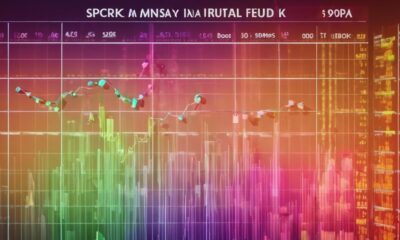
 IRA Investing2 weeks ago
IRA Investing2 weeks agoWhere Does Your IRA Invest?
-

 Retirement Planning2 weeks ago
Retirement Planning2 weeks agoDecoding Retirement Planning 567













